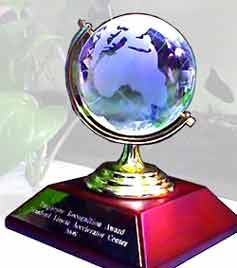

Thursday - April 13, 2006
SLAC Today is
available online at:
http://today.slac.stanford.edu
In this issue:
SLAC Awards
2006 Globies
Science Today: ILC Milestone
Valuable Real Estate in the Research Yard
 |
 |
|
Thursday - April 13, 2006 |
 SLAC Awards 2006 GlobiesThe 2006 Employee Recognition Awards ("globies") have been awarded this year to 33 deserving recipients across SLAC:
The globie awards are about people promoting a positive, respectful, and harmonious work environment. Read more... |
||||||||||||||||||||||||||
|
|
||||||||||||||||||||||||||
 ILC Milestone
The International Linear Collider (ILC) group at SLAC recently achieved a milestone with the first generation of 1.3 GHz rf power at End Station B. This comes a year and half after the decision that the ILC would use 1.3 GHz superconducting cavities for the main linacs. The then NLC—now renamed ILC—group switched from developing high frequency, short pulse rf technology for a SLAC-like linear accelerator (11.4 GHz, 1.5 microsecond), to the low frequency, long pulse rf technology chosen for the ILC (1.3 GHz, 1.5 millisecond). To gain experience with the new technology, an rf source was assembled using a high voltage modulator borrowed from the Spallation Neutron Source in Tennessee, an SDI-legacy klystron purchased from an East Bay company and a low-power rf drive system built at SLAC. This configuration successfully produced 3 MW of rf power in 1-millisecond-long pulses. Now that the initial tests are complete, the modulator is being upgraded to power ILC prototype 10 MW klystrons. The source will also be used to test input power couplers for the superconducting cavities and prototype normal-conducting cavities for the ILC positron accelerator. |
Valuable Real Estate
|
Events (see all | submit)
Access (see all)
Announcements
|
||||||||||||||||||||||||
| | ||||||||||||||||||||||||||
What's Cookin' at the Linear Cafe (see weekly menu)
|
||||||||||||||||||||||||||
|
|
||||||||||||||||||||||||||
 <%
Response.AddHeader "Last-modified", getArticleDate()
'Response.AddHeader "Last-modified","Mon, 01 Sep 1997 01:03:33 GMT"
'Monday, December 06, 2010
%>
<%
Response.AddHeader "Last-modified", getArticleDate()
'Response.AddHeader "Last-modified","Mon, 01 Sep 1997 01:03:33 GMT"
'Monday, December 06, 2010
%>View online at http://today.slac.stanford.edu/. |
||||||||||||||||||||||||||